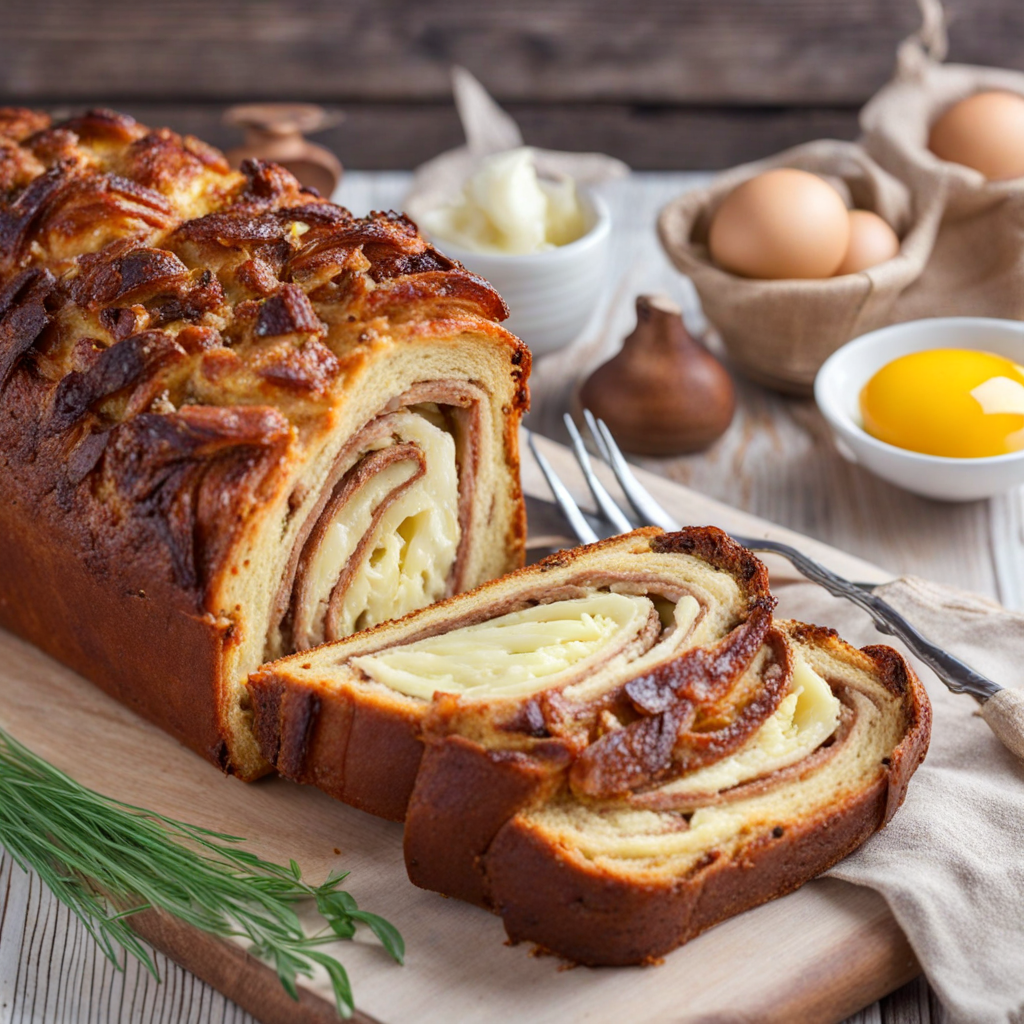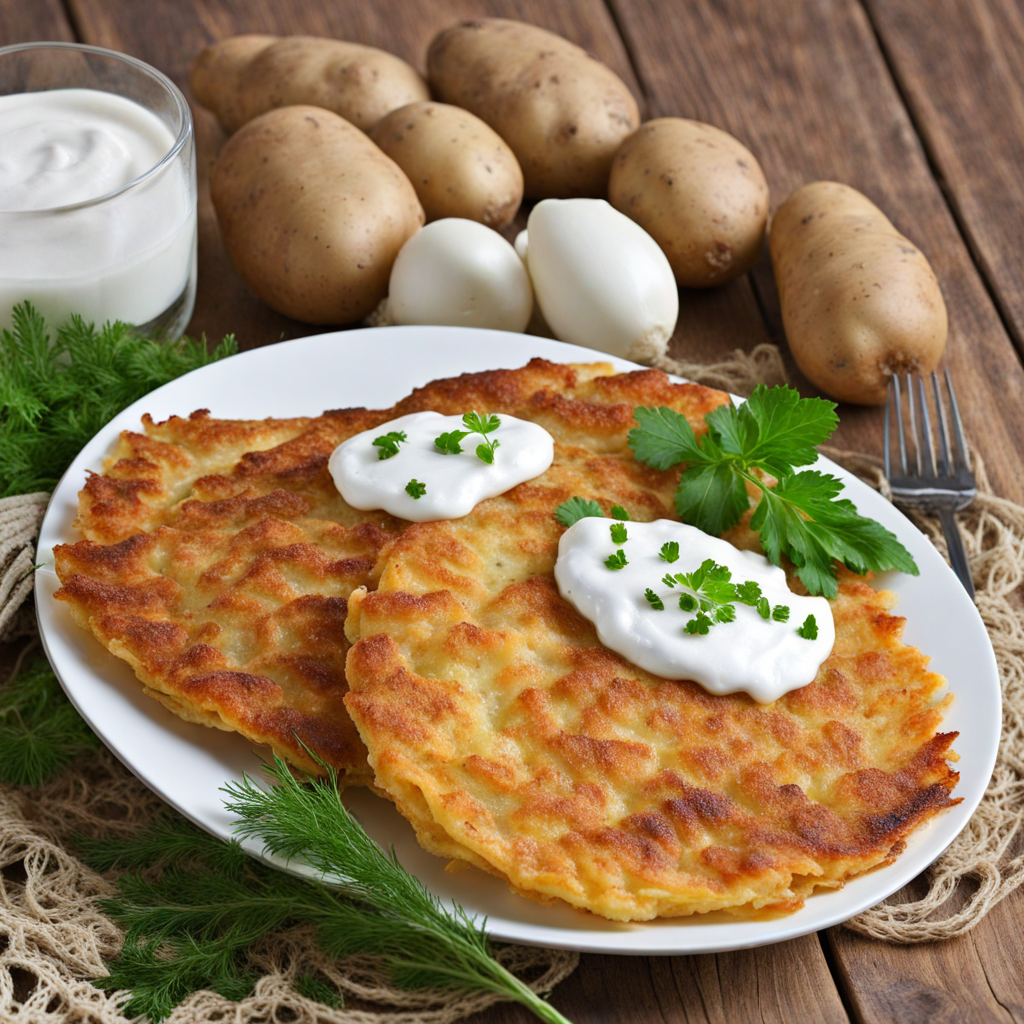Syrniki
Syrniki are delightful, golden-brown cheese pancakes that originate from Eastern Europe, particularly cherished in Belarus. Made primarily from tvorog, a type of farmer's cheese, these pancakes are light, fluffy, and packed with a slightly tangy flavor. The dough is typically enriched with eggs, flour, and sugar, creating a sweet yet savory treat that can be enjoyed at any time of the day. The texture is reminiscent of a soft, creamy bite that melts in your mouth, while the crisp exterior provides a satisfying contrast. Served warm, syrniki can be topped with a variety of accompaniments that enhance their flavor profile. Traditional toppings include sour cream, which adds a creamy richness, or a drizzle of honey for a touch of sweetness. Fresh fruits such as berries are also popular, offering a refreshing burst of flavor that complements the cheese's subtle tang. Some variations incorporate vanilla or other flavorings into the batter, allowing for a personalized twist on this beloved dish. In Belarus, syrniki are not just a breakfast item; they can be enjoyed as a snack or dessert, making them a versatile choice for any meal. Their comforting taste and simple ingredients make them a staple in many households, showcasing the warmth of Belarusian hospitality. For those looking to explore new flavors, syrniki offer a delicious entry point, inviting you to savor a piece of Belarusian culture with each bite.
How It Became This Dish
The History of Сырники: A Belarussian Culinary Delight Introduction Сырники, or syrniki, are delightful little pancakes made predominantly from cottage cheese (or tvorog), flour, eggs, and sugar. These soft, fluffy treats are not only a staple in Belarusian cuisine, but they also have a rich history and cultural significance that stretches across Eastern Europe. Their delightful texture and versatile nature make them a beloved dish in many households, transcending borders and uniting people through the simple joy of food. Origins of Сырники The origins of сырники can be traced back to the Slavic cultures, where dairy farming has been an integral part of life for centuries. The use of cottage cheese in cooking is a reflection of the agricultural practices of the region, where dairy cows were commonly raised for milk production. As early as the 10th century, Slavic peoples began to experiment with various ways to prepare and preserve dairy products, leading to the development of tvorog. The earliest iterations of сырники likely emerged as a practical solution to utilize leftover cheese, particularly the curds that formed during the cheese-making process. With the harsh winters of Eastern Europe, preserving food was crucial, and these pancakes provided a convenient way to make use of dairy products. As they were cooked on a stovetop, they offered a warm, comforting meal during the colder months. Cultural Significance Сырники hold a special place in Belarusian culture and are emblematic of the rustic culinary traditions that have been passed down through generations. In Belarus, they are often enjoyed as a breakfast dish or a snack, served warm with a variety of toppings such as sour cream, jam, honey, or fresh berries. The dish is not only a comfort food but also a nostalgic reminder of home for many Belarusians, invoking memories of family gatherings and Sunday breakfasts. The cultural significance of сырники extends beyond mere sustenance. They are often associated with hospitality and the warmth of home cooking. In Belarusian families, preparing сырники together becomes a cherished ritual, often involving multiple generations. Grandmothers pass down their secret recipes, and children learn the art of mixing the ingredients and shaping the pancakes. This communal experience fosters a sense of belonging and continuity within families and communities. Development Over Time As Belarusian society evolved, so did the recipe for сырники. While the basic ingredients remained largely unchanged, regional variations began to emerge, influenced by local customs and available ingredients. For instance, in some regions, people might add potatoes, pumpkin, or apples to the mixture, creating unique flavor profiles that reflect the local agricultural landscape. In the 20th century, the culinary landscape of Belarus underwent significant changes due to historical events, including the impact of wars and the Soviet era. During the Soviet period, traditional dishes like сырники became a symbol of national identity, representing the resilience of the Belarusian people amidst political and social upheaval. The dish was embraced in public canteens and restaurants, making it a common sight on dining tables across the country. The 1990s brought about a resurgence of interest in traditional foods as Belarus sought to rediscover and celebrate its cultural heritage following independence from the Soviet Union. Chefs and home cooks alike began to experiment with сырники, elevating them to a more gourmet status while still retaining their rustic charm. Modern interpretations might incorporate ingredients like ricotta cheese or even exotic spices, showcasing the adaptability of this beloved dish. Culinary Techniques The preparation of сырники is both an art and a science. The key to achieving the perfect texture lies in the quality of the cottage cheese used. Ideally, it should be fresh and not overly wet, as excess moisture can lead to soggy pancakes. Traditional recipes call for the cheese to be pressed through a sieve to ensure a smooth consistency. The mixture is then combined with flour, eggs, and sugar, and shaped into small rounds before being pan-fried until golden brown. The cooking technique also plays a crucial role. Sырники are typically cooked in a cast-iron skillet or a non-stick pan, allowing for even heat distribution and a crispy exterior. Some cooks prefer to use butter for frying, while others opt for vegetable oil, creating a delightful contrast between the crisp outside and the soft, creamy inside. Regional Variations and Global Influence Beyond Belarus, сырники have found their way into the cuisines of neighboring countries, such as Russia, Ukraine, and Poland, each adopting and adapting the dish to their local tastes. In Russia, for example, they are often referred to as "tvorozhniki" and may be served with a thicker layer of sour cream or fruit preserves. In Ukraine, variations might include the addition of raisins or other dried fruits. The globalization of cuisine has also led to the emergence of сырники in international culinary scenes. As Eastern European food became more popular worldwide, many chefs began incorporating these pancakes into their menus, sometimes pairing them with unexpected flavors or modern plating techniques. This fusion aspect has not only broadened the appeal of сырники but has also allowed them to maintain relevance in contemporary gastronomy. Conclusion Сырники are more than just a delicious dish; they embody the history, culture, and resilience of the Belarusian people. From their humble beginnings as a means to utilize leftover cheese to their status as a cherished comfort food, сырники have woven themselves into the fabric of Belarusian identity. As they continue to evolve and adapt, they serve as a reminder of the importance of tradition, community, and the simple joys of sharing a meal with loved ones. Whether enjoyed at home or in a trendy café, сырники will always hold a special place in the hearts and stomachs of those who savor their delightful taste.
You may like
Discover local flavors from Belarus







